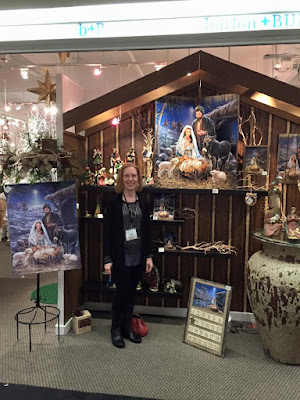How long have you been in business and how did you come to be an agent?
My parents, Brian and Dona Gelsinger, started the business in 1994, at the time it was called Little Angel Publishing. My mom had just barely started in the industry as a licensed artist with Lightpost Publishing, Thomas Kinkade’s company and they landed a deal to produce artwork for a line of collectible plates. She also did a few deals with 2 terrific agents Elise Rosenthal and Suzanne Cruise, one of those deals is still in place today actually! While Dona loved working with an experienced agent, my family wanted to take ownership of the entire process and create a larger business around Dona’s art, so we made the decision to start our own publishing and licensing company to promote and sell artwork. Over 20 years later, much has changed in the industry, but the foundational vision remains the same, creative terrific art that inspires people.
Who are the manufacturers you work with & how did you establish those relationships?
If you have really good and industry relevant art, you can usually find someone who wants to license it. The key is choosing the right partners and working together to build successful programs for everyone involved, retailer, manufacturer, agent and artist. Our aim is to build deep and longstanding, collaborative relationships with our licensing partners. Many of these relationships have spanned well over a decade and we’re honored to count many of our customers as also good friends. Some of our longest standing relationships include: The Bradford Exchange, Precious Moments/Ne’Qwa. Leanin’ Tree, Manual Woodworkers and Weavers, Evergreen, Masterpieces Puzzles and many others. We have some more recent licensing partners who are doing some exciting things as well including Burton +Burton, Timeless Treasures Fabrics, Stony Creek and Raz Imports.
Do you have employees/help?
We have 4 full time employees working on art creation, licensing and administration. We also find it’s very important to have solid go to people to help in areas outside our area of expertise, these include a copyright attorney, CPA, insurance, etc.
How do you market artists?
We use conventional tools like an online image library, eblasts, email submissions, etc. Exhibiting at Surtex is one of our best tools for finding new clients and fostering existing relationships. We attend the Atlanta gift show to see product in showrooms and meet with manufacturers. We also invest in social media marketing for both consumer awareness and as a communication tool with manufacturers. Facebook has been our primary tool, but we’re working on expanding our presence on Pinterest and Instagram as well. I can’t overstate the importance of social media, it’s here to stay and is a tremendous tool for artists.
What do you look for in an Artist?
Whether we are hiring for freelance work or partnering with a licensed artist, the first thing we need to see is a portfolio that shows a basic understanding of the industry. In our industry, the manufacturer’s purpose for licensing art is to create something they couldn’t do on their own that will help them sell more product and make more money. With that in mind, a portfolio should include themes, colors and styles that will sell in stores. It should be unique and beautiful. Finally there needs to be enough art in the portfolio to tell a story about who the artist is and demonstrate an ability to create many themes and collections.
How much work do you expect an artists to create?
There is no magic number for how many pieces an artist should create in a year, it depends on the artist’s style, what products they’re creating for and a whole host of other factors. What’s more important is for artists to be self-driven, set goals for how many collections they will create in a year and stick to a schedule. Not unlike any other career, your monetary goals should be in step with your work output. If you want to be successful, be prepared to put the time in. In addition to creating, they should also make time for studying industry trends, gathering reference materials, visiting retail stores for research, doing signing events and keeping up on social media.
Any great news you would like to share?
We’re really excited for our new product launch with Burton +Burton, they have created a whole line of gift items featuring Dona’s artwork for Christmas this year.
How has the Art Licensing business changed over the years?
Everything is much faster now in the industry. Products are in stores for shorter cycles, artwork rotates in catalogs faster and with the adoption of digital tablets and software, art is also created and modified faster. This creates opportunity because the need for new designs is growing. At the same time if you are an already established artist, you must work fast and be prolific to keep up with these cycles, otherwise you’ll find yourself losing marketshare.
Any advice or information you would like to share?
Strive to make each piece you create better than your last. Pay attention to what is selling and try to do more of that. Spend time at your easel, drawing table, tablet, whatever it may be, put in the work.
You can find Gelsinger Licensing Group
GelsingerLicensing.com
Dona Gelsinger facebook.com/donagelsinger






Thank you for sharing your story with us!
ReplyDeleteBarbara! Thank you so much for stopping by the blog!
Delete